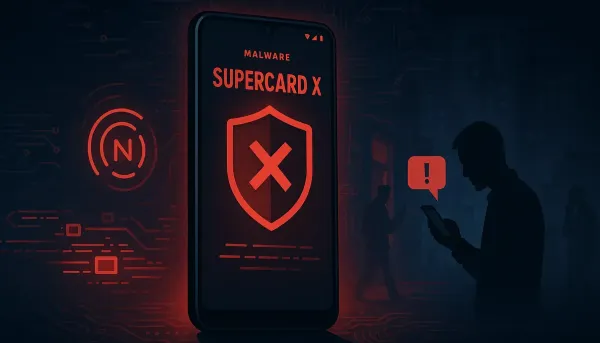
SuperCard X NFC Relay Malware- A CISO's Guide to Defense
The rapid evolution of mobile malware reflects a growing sophistication in cybercriminal tactics. One of the most alarming recent developments in this domain is the emergence of SuperCard X, a potent Android malware that exploits Near-Field Communication (NFC) relay techniques to facilitate unauthorized financial transactions. With a unique operational dynamic, SuperCard X poses a significant challenge to both consumers and financial institutions alike, transcending traditional banking fraud paradigms. This blog post seeks to dissect the technical architecture and operational methodology of SuperCard X, shedding light on its implications for the cybersecurity landscape.
The Modus Operandi of SuperCard X
Attack Vector
SuperCard X employs a blended attack methodology that begins with social engineering tactics targeting victims via SMS or messaging platforms. Scammers impersonate bank representatives, alerting victims to supposed suspicious transactions, and entice them into calling a designated number. As soon as victims engage with the ‘support’ personnel, they are led through a series of manipulations designed to harvest sensitive payment credentials, including PINs and account numbers.
Social Engineering Phases
- Initial Contact: Victims receive messages that induce panic or urgency, primarily designed to elicit immediate responses.
- Engagement: When victims call the number provided, they interact with scammers who skillfully leverage psychological manipulation to convince them to divulge personal information.
- Application Installation: Victims are ultimately persuaded to download the ‘Reader’ application, which is enveloped in a veneer of legitimacy by masquerading as a security tool.
Technical Architecture
SuperCard X operates via a dual-component architecture that integrates the Reader and Tapper applications.
- Reader: This application captures card data by requesting minimal permissions, primarily access to NFC, substantiating the malware’s low detection capabilities.
- Tapper: Following data extraction, the attackers utilize this application to impersonate victims’ cards, performing transactions without the need for physical access to the card.
The malware’s stealth is further enhanced through its use of ATRs (Answer To Reset), allowing it to represent the victim’s card as a legitimate entity to POS terminals and ATMs. This nuanced understanding of smartcard protocols illustrates the technical sophistication of the malware operators.
Communication Security
SuperCard X utilizes mutual TLS (mTLS) for communication between components, creating a secure channel that complicates surveillance efforts from cybersecurity researchers and law enforcement agencies. This encryption ensures that any intercepted data does not yield actionable intelligence against the malicious actors.
Recent Developments and Insights
As of late 2023, several cybersecurity firms have reported elevated activity linked to SuperCard X, particularly in regions with high mobile payment usage. Research by Kaspersky has indicated an increase in the distribution of SuperCard X and similar malware via malware-as-a-service (MaaS) platforms that offer tailored campaigns to affiliates.
Moreover, interest in NFC vulnerabilities has surged, prompting security researchers to stress the importance of adopting secure coding practices and ensuring robust NFC security protocols within mobile applications. A notable approach has been the implementation of enhanced device security measures, such as Secure Element (SE) and Host Card Emulation (HCE) technology, which serve as countermeasures against such attacks.
Implications for Financial Institutions
The evolving threat landscape necessitates that financial institutions reassess their security frameworks. The aggressive nature of SuperCard X poses several challenges:
- Fraud Prevention: Financial institutions must invest in advanced fraud detection systems that assess transaction behaviors in real-time, employing machine learning algorithms to identify anomalies consistent with NFC relay fraud.
- Public Awareness Initiatives: Educating consumers about recognizing phishing scams and suspicious activity is crucial. Institutions should ramp up their outreach programs to inform customers about the potential threats and advisable digital hygiene practices.
- Collaborative Cyber Intelligence: Collaboration between entities can significantly enhance awareness and preparedness. Financial institutions should engage in information sharing regarding emerging threats and vulnerability patches.
Conclusion
The emergence of SuperCard X serves as a stark reminder of the ongoing challenges within the cybersecurity landscape, particularly in the realm of mobile payments. Its sophisticated exploitation of NFC technology and social engineering tactics presents serious risks that threaten both consumers and financial systems. In confronting these challenges, a fortified approach combining technological vigilance, end-user education, and strategic collaboration is imperative. As technology continues to evolve, so too must our defenses against the sophisticated and adaptive nature of cyber threats.
By staying informed and prepared, we can proactively mitigate the risks posed by malware such as SuperCard X and safeguard valuable financial and personal information.
Through ongoing vigilance and leveraging the appropriate technological and human defense strategies, the fight against sophisticated malware endemic in the digital landscape remains both challenging and essential.